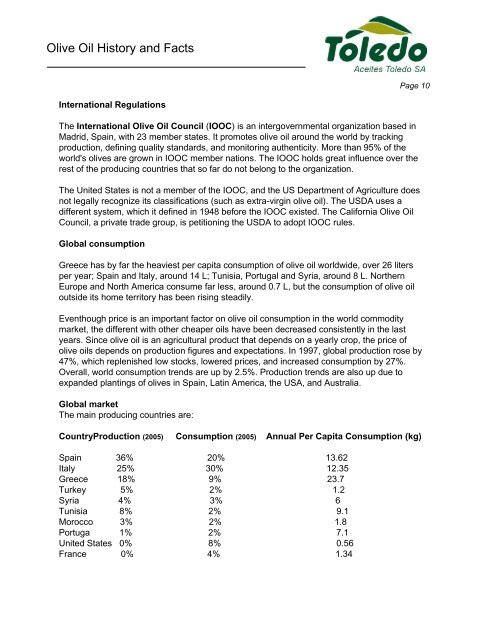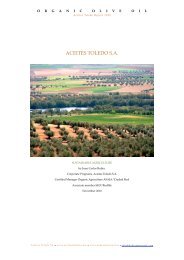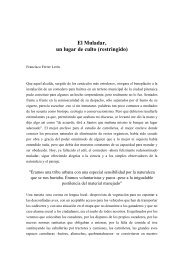On Olive Oil History and Facts. - Aceites Toledo SA
On Olive Oil History and Facts. - Aceites Toledo SA
On Olive Oil History and Facts. - Aceites Toledo SA
You also want an ePaper? Increase the reach of your titles
YUMPU automatically turns print PDFs into web optimized ePapers that Google loves.
<strong>Olive</strong> <strong>Oil</strong> <strong>History</strong> <strong>and</strong> <strong>Facts</strong><br />
Page 10<br />
International Regulations<br />
The International <strong>Olive</strong> <strong>Oil</strong> Council (IOOC) is an intergovernmental organization based in<br />
Madrid, Spain, with 23 member states. It promotes olive oil around the world by tracking<br />
production, defining quality st<strong>and</strong>ards, <strong>and</strong> monitoring authenticity. More than 95% of the<br />
world's olives are grown in IOOC member nations. The IOOC holds great influence over the<br />
rest of the producing countries that so far do not belong to the organization.<br />
The United States is not a member of the IOOC, <strong>and</strong> the US Department of Agriculture does<br />
not legally recognize its classifications (such as extra-virgin olive oil). The USDA uses a<br />
different system, which it defined in 1948 before the IOOC existed. The California <strong>Olive</strong> <strong>Oil</strong><br />
Council, a private trade group, is petitioning the USDA to adopt IOOC rules.<br />
Global consumption<br />
Greece has by far the heaviest per capita consumption of olive oil worldwide, over 26 liters<br />
per year; Spain <strong>and</strong> Italy, around 14 L; Tunisia, Portugal <strong>and</strong> Syria, around 8 L. Northern<br />
Europe <strong>and</strong> North America consume far less, around 0.7 L, but the consumption of olive oil<br />
outside its home territory has been rising steadily.<br />
Eventhough price is an important factor on olive oil consumption in the world commodity<br />
market, the different with other cheaper oils have been decreased consistently in the last<br />
years. Since olive oil is an agricultural product that depends on a yearly crop, the price of<br />
olive oils depends on production figures <strong>and</strong> expectations. In 1997, global production rose by<br />
47%, which replenished low stocks, lowered prices, <strong>and</strong> increased consumption by 27%.<br />
Overall, world consumption trends are up by 2.5%. Production trends are also up due to<br />
exp<strong>and</strong>ed plantings of olives in Spain, Latin America, the U<strong>SA</strong>, <strong>and</strong> Australia.<br />
Global market<br />
The main producing countries are:<br />
CountryProduction (2005) Consumption (2005) Annual Per Capita Consumption (kg)<br />
Spain 36% 20% 13.62<br />
Italy 25% 30% 12.35<br />
Greece 18% 9% 23.7<br />
Turkey 5% 2% 1.2<br />
Syria 4% 3% 6<br />
Tunisia 8% 2% 9.1<br />
Morocco 3% 2% 1.8<br />
Portuga 1% 2% 7.1<br />
United States 0% 8% 0.56<br />
France 0% 4% 1.34









